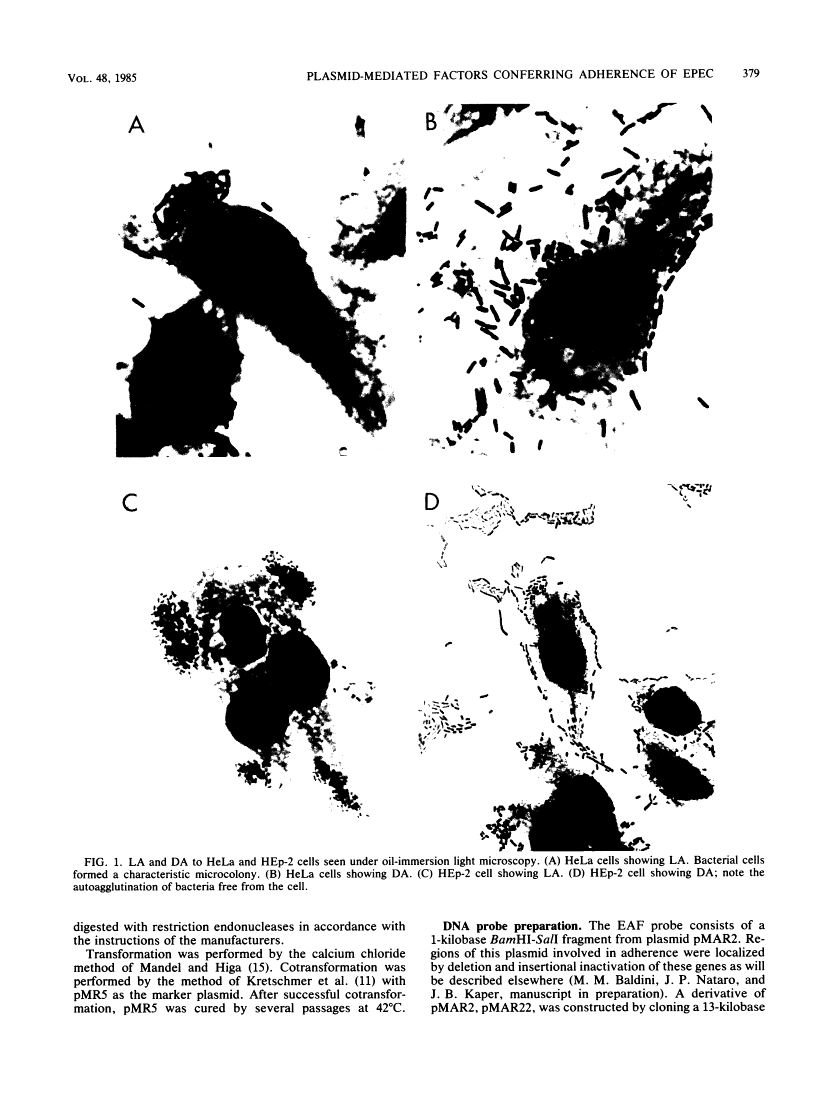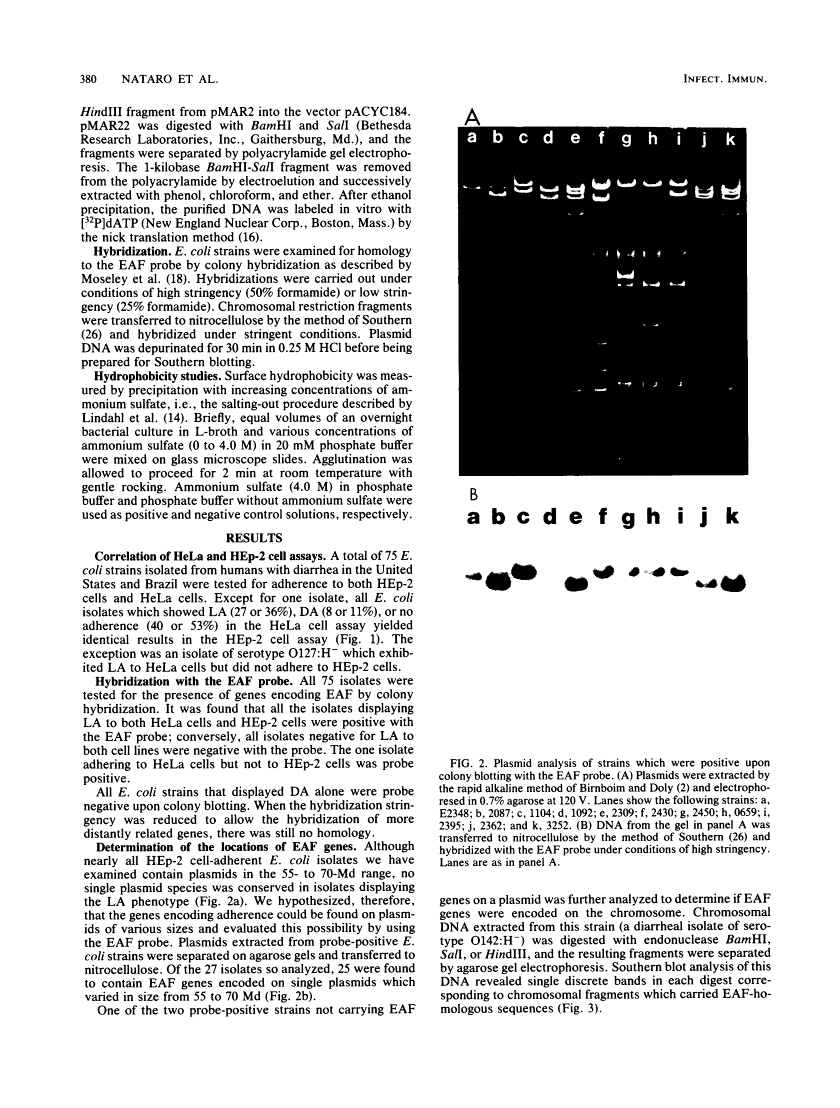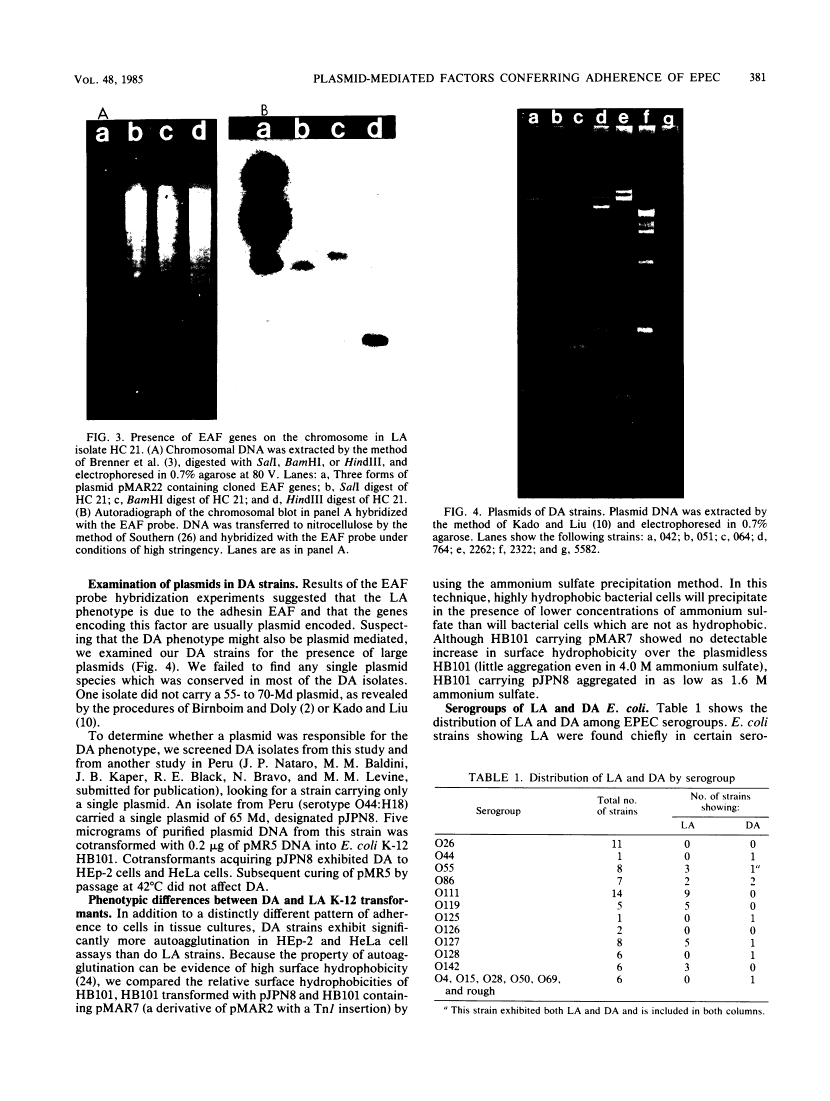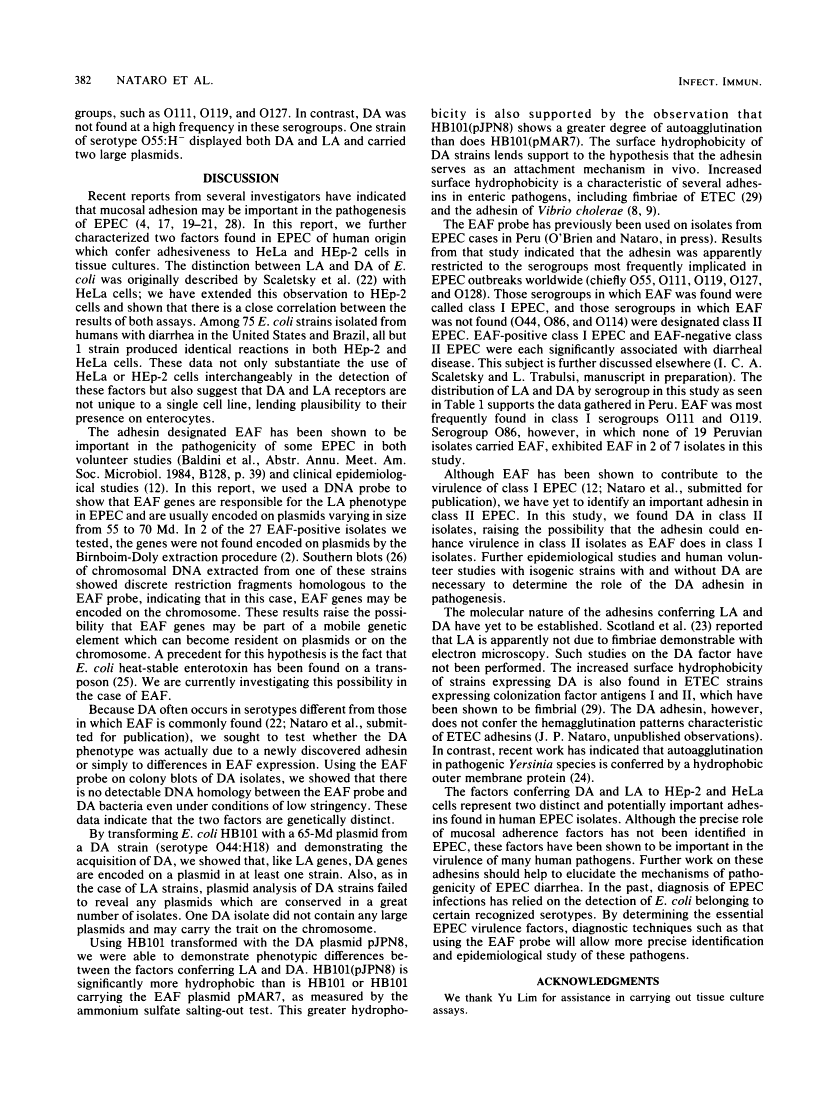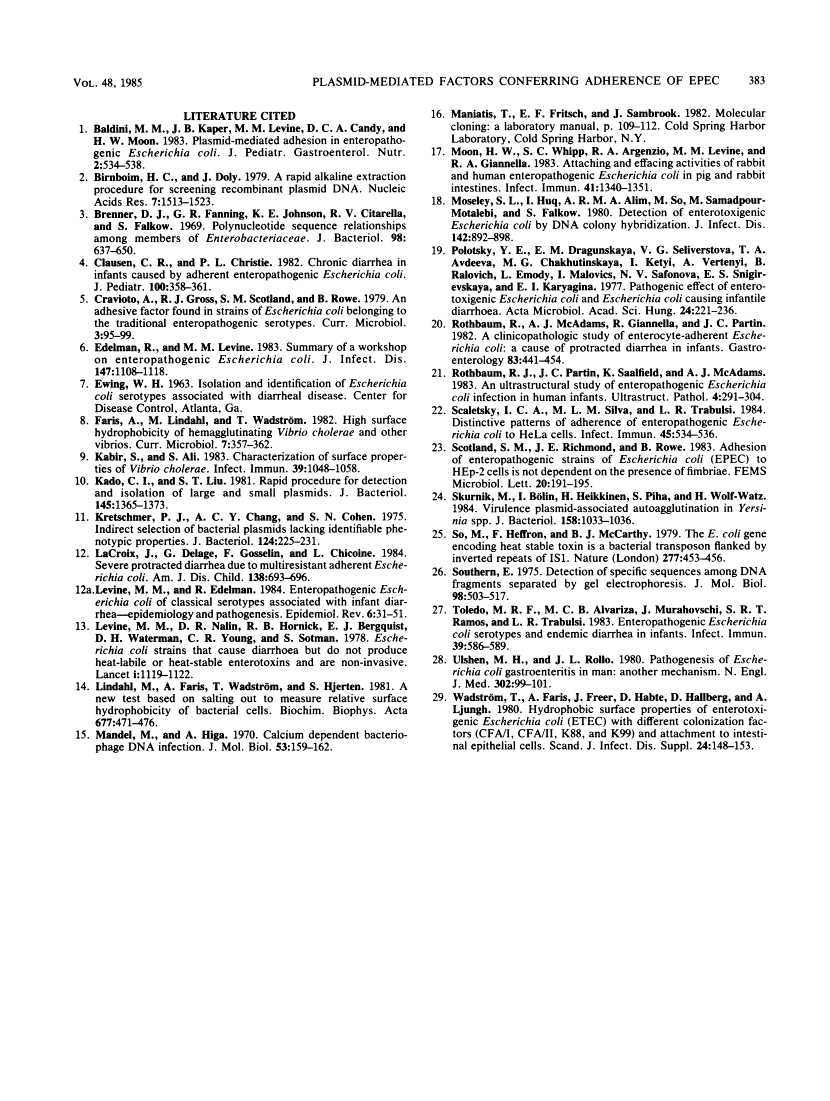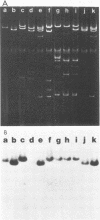Abstract
Free full text

Plasmid-mediated factors conferring diffuse and localized adherence of enteropathogenic Escherichia coli.
Abstract
Histopathological evidence suggests that the adherence of enteropathogenic Escherichia coli (EPEC) to the mucosa of the small bowel is an important step in pathogenesis. Several reports have shown that many EPEC isolates adhere to HEp-2 and HeLa cells in tissue cultures. In the HeLa cell assay, there are at least two distinct patterns of adherence: localized adherence, which is characterized by the formation of bacterial microcolonies, and diffuse adherence, in which bacteria cover the cell uniformly. We have found that these two patterns can be demonstrated in HEp-2 cells as well as in HeLa cells and that the results of the two assays are closely correlated. Using a DNA probe which is sensitive and specific for localized adherence to HEp-2 cells, we provide evidence that localized adherence and diffuse adherence by EPEC are due to at least two genetically distinct adhesions which confer phenotypic differences in both the morphology of HEp-2 cell adherence and in surface hydrophobicity. The two factors are each encoded on plasmids which vary in size from 55 to 70 megadaltons; one strain exhibiting localized adherence carried these genes on the chromosome.
Full text
Full text is available as a scanned copy of the original print version. Get a printable copy (PDF file) of the complete article (1.8M), or click on a page image below to browse page by page. Links to PubMed are also available for Selected References.
Images in this article
Selected References
These references are in PubMed. This may not be the complete list of references from this article.
- Baldini MM, Kaper JB, Levine MM, Candy DC, Moon HW. Plasmid-mediated adhesion in enteropathogenic Escherichia coli. J Pediatr Gastroenterol Nutr. 1983;2(3):534–538. [Abstract] [Google Scholar]
- Birnboim HC, Doly J. A rapid alkaline extraction procedure for screening recombinant plasmid DNA. Nucleic Acids Res. 1979 Nov 24;7(6):1513–1523. [Europe PMC free article] [Abstract] [Google Scholar]
- Brenner DJ, Fanning GR, Johnson KE, Citarella RV, Falkow S. Polynucleotide sequence relationships among members of Enterobacteriaceae. J Bacteriol. 1969 May;98(2):637–650. [Europe PMC free article] [Abstract] [Google Scholar]
- Clausen CR, Christie DL. Chronic diarrhea in infants caused by adherent enteropathogenic Escherichia coli. J Pediatr. 1982 Mar;100(3):358–361. [Abstract] [Google Scholar]
- Edelman R, Levine MM. From the National Institute of Allergy and Infectious Diseases. Summary of a workshop on enteropathogenic Escherichia coli. J Infect Dis. 1983 Jun;147(6):1108–1118. [Abstract] [Google Scholar]
- Kabir S, Ali S. Characterization of surface properties of Vibrio cholerae. Infect Immun. 1983 Mar;39(3):1048–1058. [Europe PMC free article] [Abstract] [Google Scholar]
- Kado CI, Liu ST. Rapid procedure for detection and isolation of large and small plasmids. J Bacteriol. 1981 Mar;145(3):1365–1373. [Europe PMC free article] [Abstract] [Google Scholar]
- Kretschmer FJ, Chang AC, Cohen SN. Indirect selection of bacterial plasmids lacking identifiable phenotypic properties. J Bacteriol. 1975 Oct;124(1):225–231. [Europe PMC free article] [Abstract] [Google Scholar]
- Lacroix J, Delage G, Gosselin F, Chicoine L. Severe protracted diarrhea due to multiresistant adherent Escherichia coli. Am J Dis Child. 1984 Jul;138(7):693–696. [Abstract] [Google Scholar]
- Levine MM, Edelman R. Enteropathogenic Escherichia coli of classic serotypes associated with infant diarrhea: epidemiology and pathogenesis. Epidemiol Rev. 1984;6:31–51. [Abstract] [Google Scholar]
- Levine MM, Bergquist EJ, Nalin DR, Waterman DH, Hornick RB, Young CR, Sotman S. Escherichia coli strains that cause diarrhoea but do not produce heat-labile or heat-stable enterotoxins and are non-invasive. Lancet. 1978 May 27;1(8074):1119–1122. [Abstract] [Google Scholar]
- Lindahl M, Faris A, Wadström T, Hjertén S. A new test based on 'salting out' to measure relative surface hydrophobicity of bacterial cells. Biochim Biophys Acta. 1981 Nov 5;677(3-4):471–476. [Abstract] [Google Scholar]
- Mandel M, Higa A. Calcium-dependent bacteriophage DNA infection. J Mol Biol. 1970 Oct 14;53(1):159–162. [Abstract] [Google Scholar]
- Moon HW, Whipp SC, Argenzio RA, Levine MM, Giannella RA. Attaching and effacing activities of rabbit and human enteropathogenic Escherichia coli in pig and rabbit intestines. Infect Immun. 1983 Sep;41(3):1340–1351. [Europe PMC free article] [Abstract] [Google Scholar]
- Moseley SL, Huq I, Alim AR, So M, Samadpour-Motalebi M, Falkow S. Detection of enterotoxigenic Escherichia coli by DNA colony hybridization. J Infect Dis. 1980 Dec;142(6):892–898. [Abstract] [Google Scholar]
- Polotsky YE, Dragunskaya EM, Seliverstova VG, Avdeeva TA, Chakhutinskaya MG, Kétyi I, Vertényl A, Ralovich B, Emödy L, Málovics I, et al. Pathogenic effect of enterotoxigenic Escherichia coli and Escherichia coli causing infantile diarrhoea. Acta Microbiol Acad Sci Hung. 1977;24(3):221–236. [Abstract] [Google Scholar]
- Rothbaum R, McAdams AJ, Giannella R, Partin JC. A clinicopathologic study of enterocyte-adherent Escherichia coli: a cause of protracted diarrhea in infants. Gastroenterology. 1982 Aug;83(2):441–454. [Abstract] [Google Scholar]
- Rothbaum RJ, Partin JC, Saalfield K, McAdams AJ. An ultrastructural study of enteropathogenic Escherichia coli infection in human infants. Ultrastruct Pathol. 1983 Jun;4(4):291–304. [Abstract] [Google Scholar]
- Scaletsky IC, Silva ML, Trabulsi LR. Distinctive patterns of adherence of enteropathogenic Escherichia coli to HeLa cells. Infect Immun. 1984 Aug;45(2):534–536. [Europe PMC free article] [Abstract] [Google Scholar]
- Skurnik M, Bölin I, Heikkinen H, Piha S, Wolf-Watz H. Virulence plasmid-associated autoagglutination in Yersinia spp. J Bacteriol. 1984 Jun;158(3):1033–1036. [Europe PMC free article] [Abstract] [Google Scholar]
- So M, Heffron F, McCarthy BJ. The E. coli gene encoding heat stable toxin is a bacterial transposon flanked by inverted repeats of IS1. Nature. 1979 Feb 8;277(5696):453–456. [Abstract] [Google Scholar]
- Southern EM. Detection of specific sequences among DNA fragments separated by gel electrophoresis. J Mol Biol. 1975 Nov 5;98(3):503–517. [Abstract] [Google Scholar]
- Toledo MR, Alvariza M do C, Murahovschi J, Ramos SR, Trabulsi LR. Enteropathogenic Escherichia coli serotypes and endemic diarrhea in infants. Infect Immun. 1983 Feb;39(2):586–589. [Europe PMC free article] [Abstract] [Google Scholar]
- Ulshen MH, Rollo JL. Pathogenesis of escherichia coli gastroenteritis in man--another mechanism. N Engl J Med. 1980 Jan 10;302(2):99–101. [Abstract] [Google Scholar]
- Wadström T, Faris A, Freer J, Habte D, Hallberg D, Ljungh A. Hydrophobic surface properties of enterotoxigenic E. coli (ETEC) with different colonization factors (CFA/i, CFA/ii, K88 and K99) and attachment to intestinal epithelial cells. Scand J Infect Dis Suppl. 1980;Suppl 24:148–153. [Abstract] [Google Scholar]
Associated Data
Articles from Infection and Immunity are provided here courtesy of American Society for Microbiology (ASM)
Full text links
Read article at publisher's site: https://doi.org/10.1128/iai.48.2.378-383.1985
Read article for free, from open access legal sources, via Unpaywall:
https://iai.asm.org/content/iai/48/2/378.full.pdf
Free after 4 months at iai.asm.org
http://iai.asm.org/cgi/reprint/48/2/378
Free to read at iai.asm.org
http://iai.asm.org/cgi/content/abstract/48/2/378
Citations & impact
Impact metrics
Citations of article over time
Alternative metrics

Discover the attention surrounding your research
https://www.altmetric.com/details/168067047
Article citations
Infection of mice by the enteroaggregative E. coli strain 042 and two mutant derivatives overexpressing virulence factors: impact on disease markers, gut microbiota and concentration of SCFAs in feces.
Sci Rep, 14(1):16945, 23 Jul 2024
Cited by: 0 articles | PMID: 39043759 | PMCID: PMC11266498
Differential Expression of Two Copies of the irmA Gene in the Enteroaggregative E. coli Strain 042.
Microbiol Spectr, 10(4):e0045422, 29 Jun 2022
Cited by: 1 article | PMID: 35766495 | PMCID: PMC9431211
Modulation of AggR levels reveals features of virulence regulation in enteroaggregative E. coli.
Commun Biol, 4(1):1295, 16 Nov 2021
Cited by: 5 articles | PMID: 34785760 | PMCID: PMC8595720
Enteropathogenic Escherichia coli Infection in Cancer and Immunosuppressed Patients.
Clin Infect Dis, 72(10):e620-e629, 01 May 2021
Cited by: 4 articles | PMID: 32930708 | PMCID: PMC8130029
A One Health Perspective for Defining and Deciphering Escherichia coli Pathogenic Potential in Multiple Hosts.
Comp Med, 71(1):3-45, 08 Jan 2021
Cited by: 10 articles | PMID: 33419487 | PMCID: PMC7898170
Review Free full text in Europe PMC
Go to all (134) article citations
Similar Articles
To arrive at the top five similar articles we use a word-weighted algorithm to compare words from the Title and Abstract of each citation.
Detection of an adherence factor of enteropathogenic Escherichia coli with a DNA probe.
J Infect Dis, 152(3):560-565, 01 Sep 1985
Cited by: 218 articles | PMID: 2863319
Characterization of plasmids encoding the adherence factor of enteropathogenic Escherichia coli.
Infect Immun, 55(10):2370-2377, 01 Oct 1987
Cited by: 48 articles | PMID: 2888732 | PMCID: PMC260715
Cloning and expression of an adhesin (AIDA-I) involved in diffuse adherence of enteropathogenic Escherichia coli.
Infect Immun, 57(5):1506-1511, 01 May 1989
Cited by: 161 articles | PMID: 2565291 | PMCID: PMC313306
Adhesive properties of enteropathogenic Escherichia coli isolated from infants with acute diarrhea in Africa.
Eur J Clin Microbiol Infect Dis, 8(11):979-983, 01 Nov 1989
Cited by: 12 articles | PMID: 2513199

